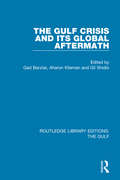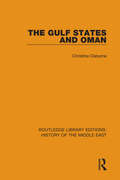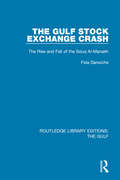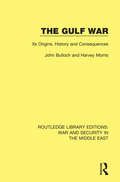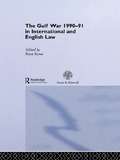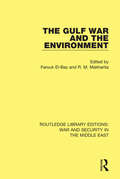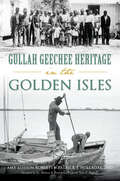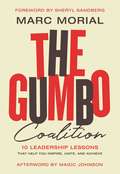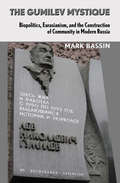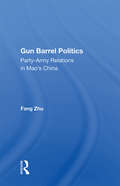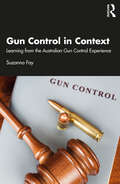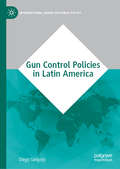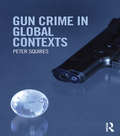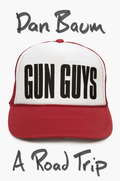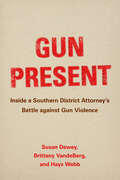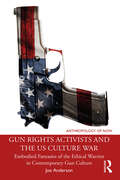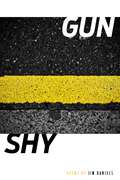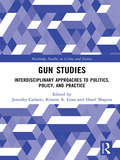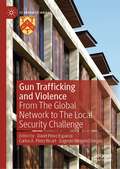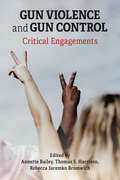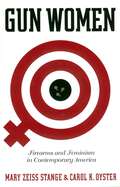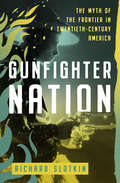- Table View
- List View
The Gulf Crisis and its Global Aftermath (Routledge Library Editions: The Gulf #6)
by Gad Barzilai Aharon Klieman Gil ShidloThe crisis in the Gulf of 1990-1 affected more than just the regional powers in the area. Rippling outward, its military, economic and political effects were felt throughout the international political system, testing US steadfastness in the face of Saddam Hussein’s political survival, European ability to form a united front on foreign policy issues and the effectiveness of the UN in confronting international aggression. The rationale behind this book, first published in 1993, is to investigate and analyse the various aspects of the crisis, especially in regard to the interactions between internal and international prospects for a new order in the Middle East. It also examines the wider effects of the war, and includes analysis of Europe, America and the Soviet Union. Each one of the essays chosen for this volume has been written by an expert in their field. This collaboration between historians, regional specialists and political scientists, integrating a variety of research methods in the framework of one book, will be useful to a wide range of readers.
The Gulf States and Oman (Routledge Library Editions: History of the Middle East #6)
by Christine OsborneThe discovery of oil brought enormous change to the Gulf. It transformed the simple fishing and grazing economies of the Gulf states into some of the wealthiest countries in the world. This book, first published in 1977, examines the impact of oil and oil wealth on the Gulf states. It describes the clash between traditional culture and Westernisation and explodes some of the Western myths about social and economic development in the area. It covers both economic change and progress in education, social welfare, urbanisation and industrial diversification. A unique collection of photographs accompanies the authoritative text.
The Gulf Stock Exchange Crash: The Rise and Fall of the Souq Al-Manakh (Routledge Library Editions: The Gulf Ser. #7)
by Fida DarwicheThe collapse of Souq Al-Manakh in Kuwait in August 1982 was the most spectacular financial crash of recent years. The market had developed as a parallel stock exchange dealing in the shares of Gulf companies not resident in Kuwait. Fuelled by manic speculation, the market grew at a phenomenal rate throughout 1981 and early 1982. Inexperienced investors gambled huge sums on the shares of shell companies promoted largely for share speculation. At the height of the market US$92 billion was outstanding on nearly 30,000 postdated cheques, the usual form of payment used in the market. The financial crisis created by the collapse of the Souq Al-Manakh threatened the stability of Kuwait. The government was forced to intervene and absorb the major part of the loss. This book, first published in 1986, traces the growth of the stock market and analyses its collapse. It also discusses in detail the wider impact of this debacle on the economic life of the Gulf.
The Gulf War: Its Origins, History and Consequences (Routledge Library Editions: War and Security in the Middle East)
by John Bulloch Harvey MorrisAfter a million deaths and twice that number injured, after the destruction of much of the infrastructure of Iran and Iraq, disruption of trade throughout the Gulf and the involvement of the USA and USSR, was the Gulf War a pointless exercise, a futile conflict which achieved nothing and left the combatants at the end of it all back in exactly the same position from which they started in 1980? In this book, first published in 1989, the authors argue that the lack of territorial gain was irrelevant: the real advantages won by each side were far more important, intangible though they were. For Iran, the channelling of the energies of her people away from domestic concerns meant the continuation of the Islamic revolution and ensured the stability of the mullahs. In Iraq, the war propped up the increasingly shaky regime of Saddam Hussein. The outside world, especially the superpowers, was terrified of the spread of Muslim fundamentalism, so made no effort to prevent Iraq from trying to halt this spread. But Israel, Saudi Arabia, Syria and the oil states also had vested interests in promoting the continuation of the war.
The Gulf War 1990-91 in International and English Law
by Peter RoweThere is no doubt that international law was of major importance during the Gulf conflict of 1990-91. Military and other actions were repeatedly justified through reference to international law, and disputes about interpretation were frequent. This book provides a definitive legal analysis of the conflict, with reference both to international and to English law. Some have been tempted to argue that international law is an ineffective means of controlling the activities of a state and its armed forces from the fact that there were no war crimes trials of the leaders of Iraq, or of any other state. International law does, however, provide a set of norms either (a) agreed to by individual states through the ratification of, or accession to, a treaty, or (b) which apply to all states by the operation of customary international law and other secondary sources. This book determines these norms in order to judge the manner in which individual states recognized the binding nature of them in the conduct of their operations. The contributors include lawyers from each of the three British armed services.
The Gulf War and the Environment (Routledge Library Editions: War and Security in the Middle East)
by Farouk El-Baz R. M. MakharitaThe Gulf War inflicted dramatic environmental damage upon the fragile desert and shore environments of Kuwait and north eastern Saudi Arabia. Marine environments experienced oil spills; inland, oil lakes and burning oil wells caused widespread pollution. This book, first published in 1994, presents an in-depth analysis of these environmental disasters, their long-term consequences, and potential ways to repair the damage.
The Gulistan; or Rose-Garden of Shekh Muslihu'D-Din Sadi Shiraz
by Edward B. EastwickThis is Volume I of thirteen in a collection on Persia. Originally published in 1880, this is a translation of The Gulistan or Rose-Garden of Shekh Muslihu'D-Din Sadi Shiraz. The Gulistan of Sadi has attained a popularity in the East which, perhaps, has never been reached by any European work in this Western world. Written in the first half of the thirteen century, in Sadi's code of morals, mercy and charity are not restricted to true believers.
Gullah Geechee Heritage in the Golden Isles (American Heritage)
by Amy Lotson Roberts Patrick J. Holladay PhDThe Golden Isles are home to a long and proud African American and Gullah Geechee heritage. Ibo Landing was the site of a mass suicide in protest of slavery, the slave ship Wanderer landed on Jekyll Island and, thanks to preservation efforts, the Historic Harrington School still stands on St. Simons Island. From the Selden Normal and Industrial Institute to the tabby cabins of Hamilton Plantation, authors Amy Roberts and Patrick Holladay explore the rich history of the region's islands and their people, including such local notables as Deaconess Alexander, Jim Brown, Neptune Small, Hazel Floyd and the Georgia Sea Island Singers.
Gumbo (Louisiana True)
by Jonathan OlivierGumbo adorns menus from New Orleans to New York to New Delhi, appearing in variations such as chicken and sausage gumbo, gombo z’herbes, and seafood gumbo. Some cooks use roux, others okra, and adding tomatoes to the pot can provide extra flavor or start a fight. Within this spirit of diversity lies the beauty of gumbo.Two culinary creations—West African okra stew and Choctaw soup—helped birth Louisiana gumbo. The Choctaw ground up sassafras, called filé, while West Africans like the Bambara provided okra and rice. From there, Spanish Caribbean influences introduced hot peppers and spices, the Germans pioneered smoked sausage and andouille, and the French devised the roux. Gumbo traces the history of how colonization, slavery, immigration, industry, and seasonality all had an impact on which ingredients wound up in the gumbo pot.
The Gumbo Coalition: 10 Leadership Lessons That Help You Inspire, Unite, and Achieve
by Marc MorialTo be a great leader, you must be able to unite people from all backgrounds with seemingly competing agendas to come together under a common cause. Marc Morial, former mayor of New Orleans and current president and CEO of the National Urban League, has been such a leader and shares the lessons he learned along a legendary journey of achievement.Morial knew his calling from a young age--he was meant to be a leader in the fight for meaningful change. Growing up in the segregated South and helping his father realize an incredible victory as the first African American mayor of New Orleans, Morial was shown that, with the right tools, significant change is possible. Less than two decades later, in his own mayoral race in New Orleans,?Morial?built what he christened the &“Gumbo Coalition,&” an incredible mixture of?all of?New Orleans&’s ingredients--African Americans,?Whites, Latinos, Asians, business leaders, grassroots community activists, business leaders, clergy, and many more. Each ingredient brought its own flavor, creating a dish that was able to reduce crime and rebuild New Orleans&’s reputation with such power that the city was able to successfully attract an NBA franchise, multiple Super Bowls, and the Essence Festival, the largest African American event in the nation.Now, Morial fights on behalf of the National Urban League to create a community with a voice so strong that nothing can stand in the way of change. He is ready to teach others what he has learned along the way, by showing readers what it means to be a leader who can unite voices and create meaningful change.
The Gumilev Mystique: Biopolitics, Eurasianism, and the Construction of Community in Modern Russia
by Mark Bassin Ronald Grigor SunySince the collapse of the Soviet Union, the legacy of the historian, ethnographer, and geographer Lev Nikolaevich Gumilev (1912-1992) has attracted extraordinary interest in Russia and beyond. The son of two of modern Russia's greatest poets, Nikolai Gumilev and Anna Akhmatova, Gumilev spent thirteen years in Stalinist prison camps, and after his release in 1956 remained officially outcast and professionally shunned. Out of the tumult of perestroika, however, his writings began to attract attention and he himself became a well-known and popular figure.Despite his highly controversial (and often contradictory) views about the meaning of Russian history, the nature of ethnicity, and the dynamics of interethnic relations, Gumilev now enjoys a degree of admiration and adulation matched by few if any other public intellectual figures in the former Soviet Union. He is freely compared to Albert Einstein and Karl Marx, and his works today sell millions of copies and have been adopted as official textbooks in Russian high schools. Universities and mountain peaks alike are named in his honor, and a statue of him adorns a prominent thoroughfare in a major city. Leading politicians, President Vladimir Putin very much included, are unstinting in their deep appreciation for his legacy, and one of the most important foreign-policy projects of the Russian government today is clearly inspired by his particular vision of how the Eurasian peoples formed a historical community. In The Gumilev Mystique, Mark Bassin presents an analysis of this remarkable phenomenon. He investigates the complex structure of Gumilev's theories, revealing how they reflected and helped shape a variety of academic as well as political and social discourses in the USSR, and he traces how his authority has grown yet greater across the former Soviet Union. The themes he highlights while untangling Gumilev's complicated web of influence are critical to understanding the political, intellectual, and ethno-national dynamics of Russian society from the age of Stalin to the present day.
Gun Barrel Politics: Party-army Relations In Mao's China
by Fang ZhuThis book tests the model of civil-military dualism to explain People's Liberation Army's (PLA) political engagement and its loyalty to the party in Maoist China. It explores how the party maintained its control— through penetration of the armed forces or non-intervention and civilian control.
Gun Control in Context: Learning from the Australian Gun Control Experience
by Suzanna FayThis book approaches the gun control debate by asking what it takes to achieve acceptance of, and compliance with, gun control regulations in a community thought to be opposed and resistant. It does this by centring this question on the experience of gun dealers who occupy a dual role in the compliance process – subject to its regulations, yet central to the application of all regulatory processes. The findings are surprising in that they demonstrate more support for gun control than opposition among this group, more willingness to cooperate with authorities than resistance, and more possibility for setting the tone for support with the wider gun owning community. This book considers how policy makers in the USA can capitalise on these overtones of collaboration and concern for public safety and learn from the successes and mistakes of the Australian gun control experience.Gun Control in Context is essential reading for all those engaged across the broad spectrum of the gun control debate and offers a grounded and reasoned approach to the challenges of public policy. It will be of interest to criminologists, legal scholars, and political scientists alike.
Gun Control Policies in Latin America (International Series on Public Policy)
by Diego SanjurjoThis book analyses the crucial role that guns play in the dynamics of extreme violence engulfing Latin America and the policies that are being implemented to confront it. Gun control is surprisingly not a prominent issue in most countries of the region, but this situation is rapidly changing as proliferation and violence dramatically increase. The book adopts an extended version of John Kingdon's influential Multiple Streams Framework to explore how gun control enters political agendas and why some countries act to end gun violence and others do not. In this effort, the Brazilian Disarmament Statute and the Uruguayan Responsible Firearm Ownership Law serve as in-depth case studies that exhibit the region’s heterogeneity and put Kingdon’s policy theory to the test. Gun Control Policies in Latin America is an essential reading for anyone interested in Latin American security and public policies.
Gun Crime in Global Contexts
by Peter SquiresEvery year around three-quarters of a million people die (directly or indirectly) as a result of gun violence, with most deaths occurring in the poorest, yet also most highly weaponized parts of the world. Firearm proliferation -- 875 million global firearms -- is a direct contributor to both regional conflicts and to crime. This book attempts to understand the inter-related dynamics of supply and demand which are weaponizing the world. Now over ten years after Peter Squires’s Gun Culture or Gun Control?, the issues pertaining to gun violence and gun control have developed dramatically. With Gun Crime in Global Contexts, Peter Squires offers a cutting-edge account of contemporary developments in the politics of gun crime and the social and theoretical issues that surround the problem. This book contains: an innovative political analysis of neo-liberal globalization and weapon proliferation; an overview of recent gun control debates and gang strategies in the UK; an updated analysis of US gun politics: self-defence, race and the ‘culture war’; a critical analysis of US school and rampage shootings, how they have impacted the gun debate and how different societies have responded to mass shootings; an examination of the UN's development of an Arms Trade Treaty (2001--13); a discussion of weapon trafficking; discussions about youth gangs around the world, including those in Brazil, Kenya, West Africa, Mexico and South Africa. With its interdisciplinary perspective and global reach, this book will be important reading for academics and students interested in youth and gang crime, violent crime and comparative criminal justice, as well as peace and security studies and international relations.
Gun Guys
by Dan BaumHere is armed America--a land of machine-gun gatherings in the desert, lederhosened German shooting societies, feral-hog hunts in Texas, and Hollywood gun armories. Whether they're collecting antique weapons, practicing concealed carry, or firing an AR-15 or a Glock at their local range, many Americans love guns--which horrifies and fascinates many other Americans, and much of the rest of the world. This lively, sometimes raucous book explores from the inside the American love affair with firearms. Dan Baum is both a lifelong gun guy and a Jewish Democrat who grew up in suburban New Jersey feeling like a "child of a bitter divorce with allegiance to both parents." In Gun Guys he grabs his licensed concealed handgun and hits the road to meet some of the 40 percent of Americans who own guns. We meet Rick Ector, a black Detroit autoworker who buys a Smith & Wesson after suffering an armed robbery--then quits his job to preach the gospel of armed self-defense, especially to the resistant black community; Jeremy and Marcey Parker, a young, successful Kentucky couple whose idea of a romantic getaway is the Blue Ridge Mountain 3-Gun Championship in Bowling Green; and Aaron Zelman, head of Jews for the Preservation of Firearms Ownership. Baum also travels to New Orleans, where he enters the world of a man disabled by a bullet, and to Chicago to interview a killer. Along the way, he takes us to gun shows, gun stores, and shooting ranges trying to figure out why so many of us love these things and why they inspire such passions.In the tradition of Confederates in the Attic and Among the Thugs, Baum brings an entire world to life. Written equally for avid shooters and those who would never touch a firearm, Gun Guys is more than a travelogue. It gives a fresh assessment of the heated politics surrounding guns, one that will challenge and inform people on all sides of the issue. This may be the first book that goes beyond gun politics to illuminate the visceral appeal of guns--an original, perceptive, and surprisingly funny journey through American gun culture.
Gun Present: Inside a Southern District Attorney's Battle against Gun Violence
by Susan DeweyGun Present takes us inside the everyday operations of the law at a courthouse in the Deep South. Illuminating the challenges accompanying the prosecution of criminal cases involving guns, the three coauthors—an anthropologist, a geographer, and a district attorney—present a deeply human portrait of prosecutors’ work. Built on an immersive, community-based participatory partnership between researchers and criminal justice professionals, Gun Present chronicles how a justice assemblage comprising institutional structures and practices, relationships and roles, and individual moral and emotional worlds informs the day-to-day administration of justice. Weaving together in-depth interviews, quantitative analysis of more than a thousand criminal cases, analysis of trial transcripts, and over a year of ethnographic observations, Gun Present provides a model for scholar-practitioner collaborations.
Gun Rights Activists and the US Culture War: Embodied Fantasies of the Ethical Warrior in Contemporary Gun Culture (Anthropology of Now)
by Joe AndersonGun Rights Activists and the US Culture War is a political anthropology which explores how firearms can become associated with processes of identity formation, as well as acting as symbols of national belonging and embodied safety. In the years following Donald Trump’s election an increasingly polarised population is taking up arms against each other more often than ever before. Based on 12 months of participant observation at gun ranges, activist meetings, handgun courses, and political events, as well as interviews with gun rights activists in San Diego County, this book argues that US conservative identity is saturated with concerns about ethics, gender, and who can wield violence legitimately. The book focuses on two gun rights organisations; the first a conservative, predominantly white and male political action committee; the second a pro-LGBTQ+ firearms training group run by trans women. This book demonstrates how gun ownership gives Americans the perceived means to enact their political will through the threat of, or actual, organized violence, and that this perceived capacity explains why guns remain objects that continue to inspire such devotion and debate. Gun Rights Activists and the US Culture War will be of interest to scholars and students in anthropology, gender studies, ethnic studies, sociology, and politics, as well as a general audience of narrative non-fiction readers.
Gun Rights Activists and the US Culture War: Embodied Fantasies of the Ethical Warrior in Contemporary Gun Culture (Anthropology of Now)
by Joe AndersonGun Rights Activists and the US Culture War is a political anthropology book which explores how firearms can become associated with processes of identity formation, as well as acting as symbols of national belonging and embodied safety.In the years following Donald Trump’s election an increasingly polarised population is taking up arms against each other more often than ever before. Based on 12 months of participant observation at gun ranges, activist meetings, handgun courses, and political events, as well as interviews with gun rights activists in San Diego County, this book argues that US conservative identity is saturated with concerns about ethics, gender, and who can wield violence legitimately. The book focuses on two gun rights organisations; the first a conservative, predominantly white and male political action committee; the second a pro-LGBTQ+ firearms training group run by trans women. This book demonstrates how gun ownership gives Americans the perceived means to enact their political will through the threat of, or actual, organized violence, and that this perceived capacity explains why guns remain objects that continue to inspire such devotion and debate.Gun Rights Activists and the US Culture War will be of interest to scholars and students in anthropology, gender studies, ethnic studies, sociology, and politics, as well as a general audience of narrative non-fiction readers.
Gun/Shy (Made in Michigan Writers Series)
by Jim DanielsThe poems in Gun/Shy deal with the emotional weight of making do. Tinged with both the regrets and wisdom of aging, Jim Daniels’s poems measure the wages of love in a changing world with its vanishing currency. He explores the effects of family work—putting children to bed, leading parents to their final resting places—and what is lost and gained in those exertions. Childhood and adolescence are examined, through both looking back on his own childhood and on that of his children. While his personal death count rises, Daniels reflects on his own mortality. He finds solace in small miracles—his mother stretching the budget to feed five children with "hamburger surprise" and potato skins, his children collecting stones and crabapples as if they were gold coins. Daniels, as he always has, carries the anchor of Detroit with him, the weight both a comfort and a burden. He explores race, white privilege, and factory work. Eight Mile Road, a fraught border, pulses with division, and the echoes of music, singing through Detroit’s soiled but solid heart, resonate in these poems. His first long poem in many years, "Gun/Shy," centers the book. Through the personas of several characters, Daniels dives into America’s gun culture and the violent gulf between the fearful and the feared. Throughout, he seeks connection in likely and unlikely places: a river rising after spring rain and searchlights crossing the night sky. Comets and cloudy skies. Cement ponds and the Garden of Eden. Adolescence and death. Wounds physical and psychic. Disguises and more disguises. These are the myths we memorize to help us sleep at night, those that keep us awake and trembling. Daniels’s accessible language, subtlety, and deftness make this collection one that belongs on every poetry reader’s shelf.
Gun Studies: Interdisciplinary Approaches to Politics, Policy, and Practice (Princeton Studies In American Politics: Historical, International, And Comparative Perspectives Ser. #103)
by Jennifer Carlson Kristin A Goss Harel ShapiraAs cultural, social, political, and historical objects, guns are rich with complex and contested significance. What guns mean, why they matter, and what policies should be undertaken to regulate guns remain issues of vigorous scholarly and public debate. Gun Studies offers fresh research and original perspectives on the contentious issue of firearms in public life. Comprising global, interdisciplinary contributions, this insightful volume examines difficult and timely questions through the lens of: Social practice Marketing and commerce Critical theory Political conflict Public policy Criminology Questions explored include the evolution of American gun culture from recreation to self-protection; the changing dynamics of the pro-gun and pro-regulation movements; the deeply personal role of guns as sources of both injury and security; and the relationship between gun-wielding individuals, the state, and social order in the United States and abroad. In addition to introducing new research, Gun Studies presents reflections by senior scholars on what has been learned over the decades and how gun-related research has influenced public policy and everyday conversations. Offering provocative and often intimate perspectives on how guns influence individuals, social structures, and the state in both dramatic and nuanced ways, Gun Studies will appeal to students and researchers interested in fields such as sociology, political science, legal history, criminology, criminal justice, social policy, armaments industries, and violent crime. It will also appeal to policy makers and all others interested in and concerned about the use of guns.
Gun Trafficking and Violence: From The Global Network to The Local Security Challenge (St Antony's Series)
by David Pérez Esparza Carlos A. Pérez Ricart Eugenio Weigend VargasThis edited book addresses the issues of gun trafficking and gun violence across different regions of the world, including the Americas, Africa, Asia, Europe and Oceania. It seeks to identify global key trends on gun trafficking and related violence and discuss different enforcement measures. Each chapter is written by teams of distinguished academics and/or experienced practitioners to include practitioner insights and policy proposals on issues related to gun violence and gun trafficking. Chapters offer an overview of violence and recent gun control debates in the regions, enumerate challenges, provide lessons learnt, and recommend policy solutions. An overview of the global small arms trade is provided at the beginning alongside a comparative analysis of common challenges and significant differences across the regions. This book speaks to those in Criminology, International Relations, Public Policy, International Security, Public health and Law, and to civil society organizations, think tanks, research centers, policy analysts and policy makers involved in gun control debates.
Gun Violence and Gun Control: Critical Engagements
by Annette Bailey;Thomas S. Harrison;Rebecca Jaremko BromwichThis interdisciplinary anthology explores a wide range of intersecting issues contributing to and arising from gun violence. Millions of people are hurt and killed by gun violence globally, and the traumatic realities of these events are navigated by individuals and communities widely. In this context, gun violence fundamentally threatens social functioning in significant ways, and profoundly test the resilience of families. The resulting transformations carry social, political, legal and economic implications for mothering, family dynamics, and community engagement. This collaborative volume brings together diverse perspectives intended to deconstruct perceptions, realities, risks and impacts of gun violence, as seen by researchers, educators, community advocates, public health/health care experts, criminologists, social workers, field-based practitioners, and victims/survivors of gun violence. The distinct and broad range of contributions in this volume critically unpacks representations, stress and trauma, resilience, advocacy/activism, policymaking, family functioning, social justice and equity, governmentality and the criminal justice system, public health/health care, and community programs/interventions. Ultimately, the work is a unique contribution to the literature in which there is a lack of wide academic consideration of gun violence and a demonstrably unsatisfactory political response stretching back decades.
Gun Women: Firearms and Feminism in Contemporary America
by Mary Zeiss Stange Carol K. OysterWomen, we are told, should not own guns. Women, we are told, are more likely to be injured by their own guns than to fend off an attack themselves. This "fact" is rooted in a fundamental assumption of female weakness and vulnerability. Why should a woman not be every bit as capable as a man of using a firearm in self-defense? And yet the reality is that millions of American women--somewhere between 11,000,000 and 17,000,000--use guns confidently and competently every day. Women are hunting, using firearms in their work as policewomen and in the military, shooting for sport, and arming themselves for personal security in ever-increasing numbers. What motivates women to possess firearms? What is their relationship to their guns? And who exactly are these women? Crucially, can a woman be a gun-owner and a feminist too? Women's growing tendency to arm themselves has in recent years been political fodder for both the right and the left. Female gun owners are frequently painted as "trying to be like men" (the conservative perspective) or "capitulating to patriarchal ideas about power" (the liberal critique). Eschewing the polar extremes in the heated debate over gun ownership and gun control, and linking firearms and feminism in novel fashion, Mary Zeiss Stange and Carol K. Oyster here cut through the rhetoric to paint a precise and unflinching account of America's gun women.
Gunfighter Nation: The Myth of the Frontier in Twentieth-Century America (Mythology of the American West)
by Richard SlotkinNational Book Award Finalist: The &“impressive&” conclusion to the &“magisterial trilogy on the mythology of violence in American history&” (Film Quarterly). &“The myth of the Western frontier—which assumes that whites&’ conquest of Native Americans and the taming of the wilderness were preordained means to a progressive, civilized society—is embedded in our national psyche. U.S. troops called Vietnam &‘Indian country.&’ President John Kennedy invoked &‘New Frontier&’ symbolism to seek support for counterinsurgency abroad. In an absorbing, valuable, scholarly study, [the author] traces the pervasiveness of frontier mythology in American consciousness from 1890. . . . Dime novels and detective stories adapted the myth to portray gallant heroes repressing strikers, immigrants and dissidents. Completing a trilogy begun with Regeneration Through Violence and The Fatal Environment, Slotkin unmasks frontier mythmaking in novels and Hollywood movies. The myth&’s emphasis on use of force over social solutions has had a destructive impact, he shows.&” —Publishers Weekly &“Stirring . . . Breaks new ground in its careful explication of the continuing dynamic between politics and myth, myth and popular culture.&” —The New York Times &“A subtle and wide-ranging examination how America&’s fascination with the frontier has affected its culture and politics. . . . Intellectual history at its most stimulating—teeming with insights into American violence, politics, class, and race.&” —Kirkus Reviews
